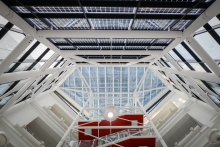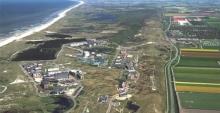News & Events
Here you can find the latest news, updates, publications and highlights.
8 March 2018
Status: Successfully tested
Description:
A real-time co-simulation of a simplified power system was succesfully performed through interconnecting laboratories of Politecnico di Torino in Italy and Shanghai Jiao Tong University in China. This is a direct connection between the two Opal-RT simulators using UDP/IP. This is a bidirectional communication and both simulators could receive data concurrently. The simple test case consists of a MV feeder of a distribution system running on PoliTo's simulator, and a set of load and generation profiles as an outcome of a prosumer behavior model on Jiao Tong's simulator. PoliTo's simulator sends voltage and current (as well as total active and reactive power injected to the feeder) measurements to Jiao Tong's; while Jiao Tong's simulator sends a set of P, Q values for all substations to PoliTo. The communication report time was set to 5 seconds (in order to update loads and generators, and also retrieve measurements) just to stress latency and reliability of the connection. It was also tested with 1 second rate. However for this kind of slow transients, ranges of minutes are also sufficient. Both models run with 250 microsecond time-step in EMT using eMEGAsim configuration
ISGT Europe 2017 — Enabling the Transition to a More Electric World
Torino, IT
26 September 2017
Link to content:
Description:
The first transatlantic real-time power system simulation is successfully performed to demonstrate the feasibility of integrating geographically distributed simulation tools, lab facilities and knowledge, in one large global laboratory (Global RT-Super Lab). Ten digital real-time simulators from OPAL-RT TECHNOLOGIES, RTDS Technologies Inc. and Typhoon HIL, Inc. located in eight leading laboratories from the US and Europe are integrated. The simulation consists of multiple AC distribution grids, an AC transmission grid, a HVDC link as well as multiple controller and power hardware-in-the-loop setups.
Other links:
Idaho National Laboratory
Youtube
Related files:
Flyer_ISGT.pdf
Pictures from the event:
AEIT 2016 Sustainable Development in the Mediterranean Area Energy and ICT Networks of the Future
Capri, Italy
5 October 2016 to 7 October 2016
Link to content:
AEIT 2016 Sustainable Development in the Mediterranean Area Energy and ICT Networks of the Future
Capri, Italy
5 October 2016 to 7 October 2016
Link to content:
1 October 2016
Description:
Partners of ERIC are discussing with a set of research institution in the US the possibility of a joint demonstration of distributed simulation across the Ocean. Main point of contacts at the moment are the Idaho National Lab (INL) and NREL (National Renewable Lab). The experiment will be performed this fall involving a network of institutions in Europe and US. The collaboration with INL is already quite active with a scientist from RWTH spending two periods of 6 months in the US.
2016 IEEE PES General Meeting (GM)
Boston, MA, USA
17 July 2016
Link to content:
Description:
During the IEEE PES General Meeting Prof. Monti presented the concept of distributed real-time simulation as a tool for future network design. The concept attracted a lot of attention and created a very constructive discussion. The concept of the ERIC Lab was also introduced and people in the room confirmed the need of this type of initiatives to move to a different scale of complexity in the modeling exercise.
Petten and Torino
15 July 2016
Status: Successfully tested
Description:
A co-simulation on the real time simulators at PoliTo in Turin and JRC in Petten was carried out in July 2016. There were some firewall issues and compatibility challenges which were resolved following some temporary solutions to establish this connection. The 2 simulators were communicating through UDP, but tunneling is needed to secure the channel and improve data exchange accuracy. The simulation case was a portion of Turin MV grid with 5 feeders and 49 substations. The application was a simple remote control of time-variant loads. A module in charge of generating load profiles in Petten periodically (every second) updates the constant PQ values of the load models in Turin.
JRC, Petten, Netherlands
15 June 2016
Description:
Following ERIC-Lab key objectives, the meeting aimed to involve more institutions and universities (e.g. Imperial College London, INPG and TU Delft) in the framework to extend the laboratories' interconnection. Some of the main remarks and discussions are:
Create informatic tunnels point to point between the different nodes, including the new members (Imperial, INPG,TUD) to demonstrate that the connection exists;
Intensify and enlarge the "catalog" of the demo applications on different levels (transmission and distribution) and with different types of simulation (pure, with HIL and/or SIL);
Extending the idea and performing a EU-US real-time co-simulation to support development of the technology for distributed real time simulation;
Development of open-source solutions to be shared, both for the interconnection part and for the simulation of big systems;
Definition of a data format for storing examples and results. For this purpose, just completed a CIM parser to automatically import network data from the operators in our choice simulator (at the moment Modelica, Phasor Dynamic, RTDS and then also OPAL).
42nd Annual Conference of IEEE Industrial Electronics Society (IEEE-IECON 2016)
Florence, Italy
23 October 2016 to 27 October 2016
Status: Accepted for presentation
18th European Conference on Power Electronics and Applications, EPE'16 ECCE Europe
Karlsruhe, Germany
5 September 2016 to 9 September 2016
Status: Accepted for presentation
A European Platform for Distributed Real Time Modelling & Simulation of Emerging Electricity Systems
Publications Office of the European Union 2016
1 June 2016
Identifier(s):
ISBN978-92-79-58545-6; ISSN1831-9424; http://dx.doi.org/10.2790/24617
Status: Published
Link to content:
Description:
This report presents the proposal for the constitution of a European platform consisting of the federation of real-time modelling and simulation facilities applied to the analysis of emerging electricity systems. Such a platform can be understood as a pan-European distributed laboratory aiming at making use of the best available relevant resources and knowledge for the sake of supporting industry and policy makers and conducting advanced scientific research. The report describes the need for such a platform, with reference to the current status of power systems; the state of the art of the relevant technologies; and the character and format that the platform might take. This integrated distributed laboratory will facilitate the modelling, testing and assessment of power systems beyond the capacities of each single entity, enabling remote access to software and equipment anywhere in the EU, by establishing a real-time interconnection to the available facilities and capabilities within the Member States. Such an infrastructure will support the remote testing of devices, enhance simulation capabilities for large multi-scale and multi-layer systems, while also achieving soft-sharing of expertise in a large knowledge-based virtual environment. ...
Torino and Aachen
15 May 2016
Status: Successfully tested


